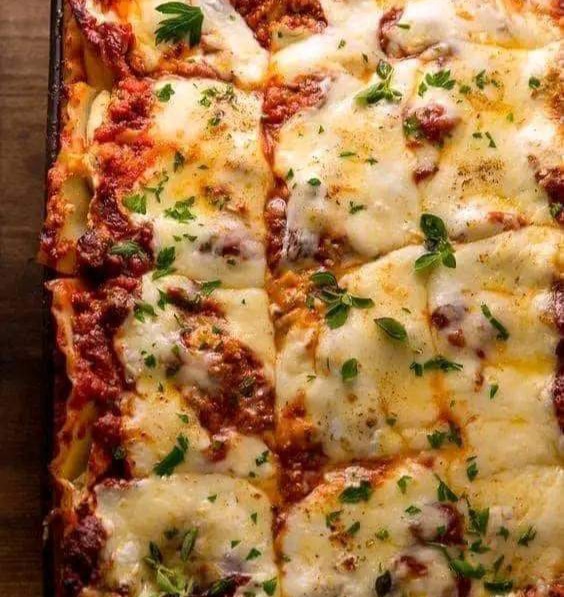Homemade lasagna is a classic Italian dish that has become a beloved comfort food worldwide.
Made with layers of tender pasta, rich meat sauce, creamy béchamel or ricotta cheese, and melted mozzarella, this hearty casserole is a perfect dish for family dinners, special gatherings, or meal prepping for the week.
Its versatility allows for various fillings and sauces, from traditional Bolognese to vegetarian or even gluten-free options.
While it may take some time to prepare, the flavorful, cheesy layers make it well worth the effort, offering a satisfying meal everyone .
INGREDIENTS:
1 tablespoon olive oil
1 small onion, diced
1 pound ground beef
1 pound Italian sausage
1 28 ounce canned crushed tomatoes
2 cans 6 .5 oz. tomato sauce
1 6-ounce can tomato paste
2 tablespoons Italian seasoning
1/4 cup sugar
salt and pepper to taste
1 tablespoon chopped fresh basil
12 lasagna noodles
16 ounces ricotta cheese
1 /2 cups finely grated Parmesan cheese
1 egg
2 cups grated mozzarella cheese
INSTRUCTIONS:
Step 1: In a large pan over medium-high heat, add olive oil and onion.
Stir-fry until tender then add ground beef and sausage.
Cook and mash until golden and cooked.Add crushed tomatoes, tomato sauce, tomato paste, Italian seasoning, sugar and basil.
Let boil over low heat.
Step 2: Put water in a large pot and boil. Add lasagna and cook 8 to 10 minutes. Drain and rinse with cold water.
Step 3: In a medium bowl, add ricotta, parmesan cheese and eggs. Stir until combined.
Step 4: Preheat oven to 375 degrees and spray a 9×13 inch baking dish with nonstick cooking spray and set aside.
Step 5: To prepare lasagna, start by spreading 1 cup of meat sauce on the bottom of the pan.
Arrange the noodles in a single layer on top of the meat sauce.
Spread 1/2 cup ricotta cheese over the noodles, then sprinkle with shredded mozzarella cheese.
Repeat layers and cover with cheese.
Step 6: Cover with foil and bake for 20 minutes. Remove foil and bake for another 20 to 25 minutes or until heated through and cheese is bubbly.
Let cool for 10 minutes before using.
Variations:
Classic Meat Lasagna: Stick to the traditional recipe using ground beef or a mix of beef and pork for a rich, flavorful meat sauce.
Layer it with marinara and ricotta cheese for a classic taste.
Vegetarian Lasagna: Swap out the meat for a variety of vegetables like spinach, zucchini, mushrooms, and bell peppers.
You can also add ricotta or cottage cheese for a creamy texture.
White Sauce Lasagna: Instead of a tomato-based sauce, use béchamel (white sauce) with chicken, spinach, or mushrooms for a lighter yet creamy variation.
Gluten-Free Lasagna: Use gluten-free lasagna noodles or replace the pasta with thin slices of vegetables like zucchini or eggplant to create a low-carb, gluten-free option.
Cheese Lasagna: For cheese lovers, layer extra mozzarella, Parmesan, ricotta, and even provolone between the noodles for an ultra-cheesy version.
Seafood Lasagna: For a more unique take, substitute the meat with shrimp, crab, or a combination of seafood, and pair it with a light cream sauce for a seafood-inspired dish.
Tips:
Use No-Boil Noodles: To save time, use no-boil lasagna noodles.
They soften while baking and absorb some of the sauce, resulting in a perfectly cooked lasagna.
Make Ahead: Lasagna is a great dish to prepare ahead of time.
Assemble it the night before, refrigerate, and bake the next day.
You can also freeze unbaked lasagna for future meals.
Let It Rest: After baking, let the lasagna rest for about 10-15 minutes before cutting into it.
This helps the layers set and makes it easier to serve.
Avoid Overloading the Sauce: While it’s tempting to add lots of sauce, too much can make the lasagna soggy.
Use just enough to coat the layers without drenching them.
Even Layers: Spread the sauce, cheese, and filling evenly over the noodles to ensure each slice has the perfect balance of flavors.
Fresh Herbs: Use fresh basil, parsley, or oregano in your sauce or as a garnish for a fresh, authentic Italian flavor.
Cheese Crust: For a golden, crispy top, sprinkle a generous amount of Parmesan or mozzarella cheese over the final layer and bake uncovered for the last 10 minutes.
By experimenting with different ingredients and following these tips, you can customize your lasagna to suit your taste and dietary preferences!
The nutritional content of homemade lasagna can vary depending on the ingredients and portion sizes.
Below is an approximate estimate for a classic meat and cheese lasagna based on a typical recipe (using ground beef, ricotta cheese, mozzarella, Parmesan, lasagna noodles, and marinara sauce).
The values are for one serving (about 1/8 of a 9×13-inch pan):
Approximate Nutritional Information per Serving:
Calories: 400-500 kcal
Protein: 25-30 g
Carbohydrates: 35-45 g
Sugars: 6-10 g
Fat: 20-25 g
Saturated Fat: 10-12 g
Cholesterol: 70-90 mg
Sodium: 800-1000 mg
Fiber: 3-5 g
Factors Affecting Nutritional Content:
Meat Choices: Using lean ground beef or turkey instead of regular ground beef can reduce the fat and calorie content.
Cheese: Using low-fat ricotta, mozzarella, or reducing the amount of cheese will also decrease fat and calories.
Pasta: Whole wheat or gluten-free noodles add more fiber and lower the glycemic impact.
Sauce: Homemade marinara with less added sugar and salt can make the lasagna healthier.
This nutritional information can fluctuate based on recipe modifications like adding vegetables, changing meats, or using alternative cheeses.
ENJOY
